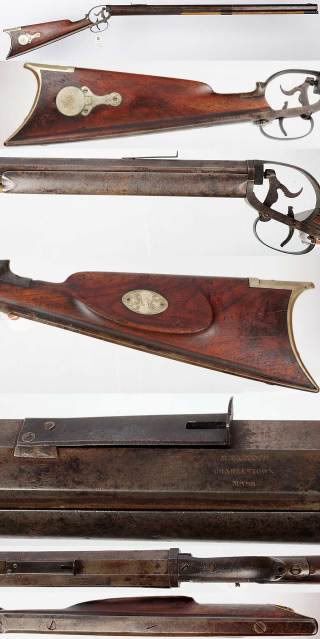There is a myth floating around that Jean Samuel Pauly invented an "inline" ignition for a gun in 1808. What he and a French fellow named François Prélat developed, was an early, black powder breech loading rifle. This was later developed into the needle gun, which is a bolt action design, slightly cosmetically similar to many of the modern muzzleloaders, but NOT a muzzleloader.
Part of the modern myth may stem from the use in 1836 of a papier mache "sabot" used with bullets in Pauly/Dreyse cartridges, fired through Dreyse needle guns used by the Prussians.
Some folks seem to confuse the working of the action as the criteria for the naming of the modern muzzleloading rifles sold today, when it's the line formed from the external cap, to the main charge, to the muzzle that is the origin of the name.
There is a Spanish made SxS in existence, as well as a single shot gun in the Tower of London (made by a Bohemian fellow), that use an actual inline, flintlock ignition. They are ingenious, but if you like your eyebrows..., not very practical. The flint is driven forward like the edge of a coal shovel against the frizzen, which is closed as part of a sort of hatch, and when closed over the priming powder it is flush with the top surface of the barrel, as part of the breech of the barrel. So the flint strikes the fizzen, forcing it upwards and open and causing a spark to hit the prime, and boom. Probably an attempt at weather proofing the flintlock..., with the only problem being the frizzen opens toward the shooter's face as is the touch hole, and the frizzen also blocks the sights....
Here is an earlier thread on the rifle The Paczelt gun c. 1738
Folks also point to the Hall 1819 Rifle..., but that's a breech loader.
Modern muzzleloading rifles aren't flintlocks.... Any more than single shot, breech loading rifles are muzzleloaders, or are "primitive"..., even though one state considers them so...
Regardless of the materials used to build the rifle..., for a modern muzzleloading rifle to claim it is an actual decendant of a previously used ignition system..., I'd like to see an example of a caplock rifle, where there is a straight line from the cap, through the nipple mounted in the breech plug, to the main charge with the projectile, through the barrel and out the muzzle.
Is that too much to ask? :v:
:stir: :dead:
LD
Part of the modern myth may stem from the use in 1836 of a papier mache "sabot" used with bullets in Pauly/Dreyse cartridges, fired through Dreyse needle guns used by the Prussians.
Some folks seem to confuse the working of the action as the criteria for the naming of the modern muzzleloading rifles sold today, when it's the line formed from the external cap, to the main charge, to the muzzle that is the origin of the name.
There is a Spanish made SxS in existence, as well as a single shot gun in the Tower of London (made by a Bohemian fellow), that use an actual inline, flintlock ignition. They are ingenious, but if you like your eyebrows..., not very practical. The flint is driven forward like the edge of a coal shovel against the frizzen, which is closed as part of a sort of hatch, and when closed over the priming powder it is flush with the top surface of the barrel, as part of the breech of the barrel. So the flint strikes the fizzen, forcing it upwards and open and causing a spark to hit the prime, and boom. Probably an attempt at weather proofing the flintlock..., with the only problem being the frizzen opens toward the shooter's face as is the touch hole, and the frizzen also blocks the sights....
Here is an earlier thread on the rifle The Paczelt gun c. 1738
Folks also point to the Hall 1819 Rifle..., but that's a breech loader.
Modern muzzleloading rifles aren't flintlocks.... Any more than single shot, breech loading rifles are muzzleloaders, or are "primitive"..., even though one state considers them so...
Regardless of the materials used to build the rifle..., for a modern muzzleloading rifle to claim it is an actual decendant of a previously used ignition system..., I'd like to see an example of a caplock rifle, where there is a straight line from the cap, through the nipple mounted in the breech plug, to the main charge with the projectile, through the barrel and out the muzzle.
Is that too much to ask? :v:
:stir: :dead:
LD








